Beginning next month, the Education Department will resume withholding money from tax refunds and Social Security benefits to pay down the debt of people in default on their student loans, ending a five-year pause on involuntary collections. Wage garnishments will restart this summer.
Roughly 5.3 million borrowers are in default, having failed to make a payment on their loan for at least 360 days before the federal government stopped referring past-due debts for collection because of the pandemic. Those borrowers could face some of the most severe consequences of default when the agency restarts collections May 5.
“American taxpayers will no longer be forced to serve as collateral for irresponsible student loan policies,” Education Secretary Linda McMahon said in a statement Monday. “The Biden Administration misled borrowers: the executive branch does not have the constitutional authority to wipe debt away, nor do the loan balances simply disappear.”
The resumptions arrive as delinquencies on federal student loans climb. Four million people who are supposed to be making payments on their loans were more than 90 days and up to 180 days past due as of late March, according to the Education Department.
The rise in delinquencies corresponds with the end of a 12-month grace period, known as the on-ramp, that allowed borrowers to ease their way back into repayment after a pause that lasted more than three years. Since the Biden administration’s policy ended Sept. 30, millions of borrowers have fallen behind on payments.
If those delinquencies become full-blown defaults by summer, almost 25 percent of the federal student loan portfolio will be in default, the department said Monday. On a call with reporters, a senior official said the portfolio is headed toward a “fiscal cliff” if the Trump administration doesn’t restart involuntary collections.
McMahon said her agency, with the help of the Treasury Department, “will shepherd the student loan program responsibly and according to the law, which means helping borrowers return to repayment — both for the sake of their own financial health and our nation’s economic outlook.”
In the coming weeks, the Education Department plans to email borrowers in default on their loans with options for bringing their debt back into good standing. A second Biden administration initiative, called “Fresh Start,” had allowed anyone in default on a federal loan held by the department to rehabilitate that loan.
After contacting people in default, officials will turn their attention to delinquent borrowers. Nearly 35 percent of the portfolio is more than 60 days past due.
Only 38 percent of student loan borrowers are making payments on their loans, but that paltry rate is in part the result of an ongoing lawsuit blocking former president Joe Biden’s Saving on a Valuable Education (SAVE) program.
Because of an injunction in the case, the Education Department postponed the payments for 8 million borrowers enrolled in the program. The department also stopped accepting and processing applications for income-driven repayment plans, which tie monthly payments to earnings and family size with the promise of loan forgiveness after 20 to 25 years.
The injunction left 1.9 million people stuck in forbearance until their applications for repayment could be processed. Starting next month, the department said it will resume processing those.
President Donald Trump imposed a moratorium during his first term on the collection of defaulted student loans; Congress later codified and extended that freeze in the 2017 stimulus package. The Biden administration extended it several times as part of the broader pause on payments.



